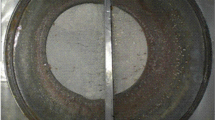Abstract
Introduction
Operation of steam turbine structural elements is characterized by heavy mechanical and thermal loading in corrosive environment. One of the main consequences of such operation conditions is the fatigue damage of steam turbine structural elements, which accumulates for a long time and finally develops into local damage of a fatigue crack type.
Methods
To estimate the fatigue crack growth rate in steam turbine shaft in the process of transverse vibrations when rotor passes through the first critical speed the analytical model has been developed. As a model object, the high-pressure rotor of the K-210-130 steam turbine was chosen. The durability of cracked rotor in terms of start-ups number was estimated with the fracture mechanics theory based on the calculated stresses in the cracked area, as well as on the experimentally determined crack growth rate for the rotor steel.
Conclusion
Crack growth relationships were established depending on the size of the initial crack, angular acceleration of the rotor, and a number of other parameters. The angular acceleration, rotor’s eigenfrequency and damping have the most essential impact on the intensity of crack growth.








Similar content being viewed by others
Data Availability
The data are available.
References
Chernousenko O, Ryndiuk D, Peshko V (2020) Estimation of residual life and extension of operation of high-power steam turbines. Part 3. NTUU KPI. Kyiv.
Miller DA, Lagoudas DC (2000) Influence of heat treatment on the mechanical properties and damage development in a SiC/Ti-15-3 MMC. J Eng Mater Tech, Trans ASME 122(1):74–77. https://doi.org/10.1115/1.482768
Tekkaya AE, Bouchard P-O, Bruschi S, Tasan CC (2020) Damage in metal forming. CIRP Ann Manuf Technol 69(2):600–623. https://doi.org/10.1016/j.cirp.2020.05.005.hal-03099345
Soori M, Asmael M (2020) Mechanical behavior of materials in metal cutting operations, a review. J New Tech Mater, Université Larbi Ben Mhidi de Oum El Bouaghi 10(2):79–82
Nikravesh MY, MeidanSharaf M (2016) Failure of a steam turbine rotor due to circumferential crack growth influenced by temperature and steady torsion. Eng Fail Analys 66:296–311. https://doi.org/10.1016/j.engfailanal.2016.03.020
Barella S, Bellogini M, Boniardi M, Cincera S (2011) Failure analysis of a steam turbine rotor. Eng Fail Analys 18(6):1511–1519. https://doi.org/10.1016/j.engfailanal.2011.05.006
Troshchenko VT, Khamaza LA (2018) Fatigue fracture stages of metals and alloys and stage-to-stage transition criteria. Strength Mater 50(3):529–539. https://doi.org/10.1007/s11223-018-9998-1
Kramer LD, Randolph DD (1976) Analysis of the Tennessee valley authority, Gallatin unit N2 turbine rotor burst. In: ASME-MPC Symp. on Creep-Fatigue Interaction, pp. 1.
Zagretdinov ISh, Kostyuk AG, Trukhnii AD, Dolzhanskii PR (2004) Failure of the 300 MW turbine unit of the state district power station at Kashira: causes, consequences and conclusions. Thermal Eng 5:5–15
Zhou T, Xu J, Sun Z (2001) Dynamic analysis and diagnosis of a cracked rotor. J Vib Acoust Trans ASME 123(4):539–543. https://doi.org/10.1115/1.1401075
Bovsunovsky AP (2015) Fatigue damage of steam turbine shaft at asynchronous connections of turbine generator to electrical network. J Phys Conf Ser 628:012001
Bovsunovsky A, Surace C (2015) Non-linearities in the vibrations of elastic structures with a closing crack: a state of the art review. Mech Syst Sig Proc 62–63:129–148. https://doi.org/10.1016/j.ymssp.2015.01.021
Dimarogonas AD (1996) Vibration of cracked structures-a state of the art review. Eng Fract Mech 5:831–857
Dimarogonas AD (1976) Vibration engineering. West Publishers, St. Paul
Dimarogonas AD, Paipetis SA, Chondros TG (2013) Analytical methods in rotor dynamics, 2nd edn. Springer, Dordrecht, Heidelberg, New York, London
Gunter EJ (2006) Unbalance response and field balancing of an 1150-MW turbine-generator with generator bow. In: 7th IFToMM-Conference on Rotor Dynamics, pp. 25–28.
Scientific and Technical Center for Industrial Safety (2003) Typical instructions for metal control and extension of the service life of the main elements of boilers, turbines and pipelines of thermal power plants (RD 10–577–03).
Broek D (1988) The practical use of fracture mechanics. Kluwer Academic Publishers, Dordrecht/Boston/London
Sorokin E (1954) On the issue of inelastic resistance of building materials during vibrations. State publishing house of literature on construction, Moskow
Pisarenko GS, Yakovlev AP, Matveev VV (1971) Vibration absorbing properties of structural materials (Handbook). Naukova Dumka, Kyiv
Shul’zhenko MG, Gontarovskyi PP, Garmash NG (2010) Thermostressed state and crack growth resistance of rotors of the NPP turbine K-1000-60/1500. Strength Mater 42(1):114–119. https://doi.org/10.1007/s11223-010-9197-1
Stress intensity factors handbook (1987) In: 3 vol. Vol. I. – (Editor-in-chif Y.Murakami), The Society of Materials Sci., Japan and Pergamon Press.
Troshchenko VT, Sosnovskiy LA (1987) Fatigue resistance of metals and alloys. Handbook. Naukova Dumka, Kyiv.
Shlyannikov V, Kosov D, Fedorenkov D, Zhang X-C, Tu S-T (2021) Size effect in creep–fatigue crack growth interaction in P2M steel. Fatig Fract Eng Mater Struct 44(12):3301–3319. https://doi.org/10.1111/ffe.13557
Steam turbine-generator torsional vibration interaction with the electrical network (2005) Final report. Electric power research institute. Palo Alto, California.
Bovsunovskii AP (2011) Experimental studies on high-cycle fatigue and damping properties of R2MA rotor steel in torsion. Strength Mater 43(4):455–463. https://doi.org/10.1007/s11223-011-9315-8
Author information
Authors and Affiliations
Corresponding author
Additional information
Publisher's Note
Springer Nature remains neutral with regard to jurisdictional claims in published maps and institutional affiliations.
Rights and permissions
Springer Nature or its licensor (e.g. a society or other partner) holds exclusive rights to this article under a publishing agreement with the author(s) or other rightsholder(s); author self-archiving of the accepted manuscript version of this article is solely governed by the terms of such publishing agreement and applicable law.
About this article
Cite this article
Bovsunovsky, A., Chernousenko, O. Estimation of Fatigue Crack Growth at Transverse Vibrations of a Steam Turbine Shaft. J. Vib. Eng. Technol. 12, 711–718 (2024). https://doi.org/10.1007/s42417-023-00869-w
Received:
Revised:
Accepted:
Published:
Issue Date:
DOI: https://doi.org/10.1007/s42417-023-00869-w




